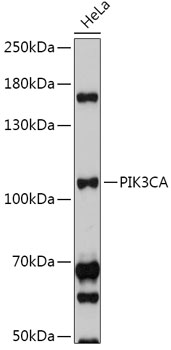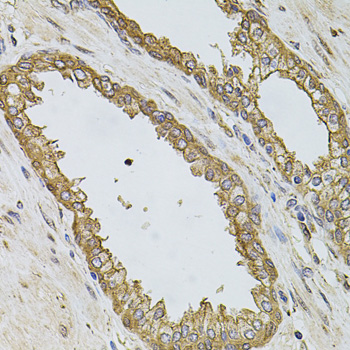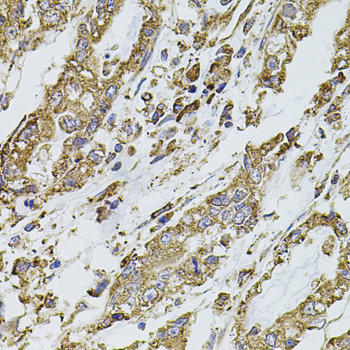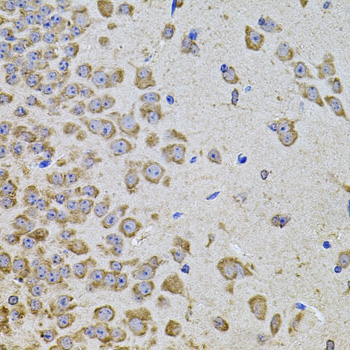-
Product Name
PIK3CA Polyclonal Antibody
- Documents
-
Description
Polyclonal antibody to PIK3CA
-
Tested applications
WB, IHC, IF
-
Species reactivity
Human, Mouse, Rat
-
Alternative names
PIK3CA antibody; CLOVE antibody; CWS5 antibody; MCAP antibody; MCM antibody; MCMTC antibody; PI3K antibody; PI3K-alpha antibody; p110-alpha antibody; phosphatidylinositol-4,5-bisphosphate 3-kinase catalytic subunit alpha antibody
-
Isotype
Rabbit IgG
-
Preparation
Antigen: Recombinant fusion protein containing a sequence corresponding to amino acids 401-600 of human PIK3CA (NP_006209.2).
-
Clonality
Polyclonal
-
Formulation
PBS with 0.02% sodium azide, 50% glycerol, pH7.3.
-
Storage instructions
Store at -20℃. Avoid freeze / thaw cycles.
-
Applications
WB 1:500 - 1:2000
IHC 1:50 - 1:100
IF 1:50 - 1:100 -
Validations

Western blot - PIK3CA Polyclonal Antibody
Western blot analysis of extracts of HeLa cells, using PIK3CA antibody at 1:500 dilution.Secondary antibody: HRP Goat Anti-Rabbit IgG (H+L) at 1:10000 dilution.Lysates/proteins: 25ug per lane.Blocking buffer: 3% nonfat dry milk in TBST.Detection: ECL Basic Kit .Exposure time: 30s.

Immunohistochemistry - PIK3CA Polyclonal Antibody
Immunohistochemistry of paraffin-embedded rat kidney using PIK3CA antibody at dilution of 1:100 (40x lens).

Immunohistochemistry - PIK3CA Polyclonal Antibody
Immunohistochemistry of paraffin-embedded human prostate using PIK3CA antibody at dilution of 1:100 (40x lens).

Immunohistochemistry - PIK3CA Polyclonal Antibody
Immunohistochemistry of paraffin-embedded human gastric cancer using PIK3CA antibody at dilution of 1:100 (40x lens).

Immunohistochemistry - PIK3CA Polyclonal Antibody
Immunohistochemistry of paraffin-embedded mouse brain using PIK3CA antibody at dilution of 1:100 (40x lens).
-
Background
Phosphoinositide-3-kinase (PI3K) that phosphorylates PtdIns (Phosphatidylinositol), PtdIns4P (Phosphatidylinositol 4-phosphate) and PtdIns(4,5)P2 (Phosphatidylinositol 4,5-bisphosphate) to generate phosphatidylinositol 3,4,5-trisphosphate (PIP3). PIP3 plays a key role by recruiting PH domain-containing proteins to the membrane, including AKT1 and PDPK1, activating signaling cascades involved in cell growth, survival, proliferation, motility and morphology. Participates in cellular signaling in response to various growth factors. Involved in the activation of AKT1 upon stimulation by receptor tyrosine kinases ligands such as EGF, insulin, IGF1, VEGFA and PDGF. Involved in signaling via insulin-receptor substrate (IRS) proteins. Essential in endothelial cell migration during vascular development through VEGFA signaling, possibly by regulating RhoA activity. Required for lymphatic vasculature development, possibly by binding to RAS and by activation by EGF and FGF2, but not by PDGF. Regulates invadopodia formation through the PDPK1-AKT1 pathway. Participates in cardiomyogenesis in embryonic stem cells through a AKT1 pathway. Participates in vasculogenesis in embryonic stem cells through PDK1 and protein kinase C pathway. Also has serine-protein kinase activity: phosphorylates PIK3R1 (p85alpha regulatory subunit), EIF4EBP1 and HRAS. Plays a role in the positive regulation of phagocytosis and pinocytosis (By similarity).
Related Products / Services
Please note: All products are "FOR RESEARCH USE ONLY AND ARE NOT INTENDED FOR DIAGNOSTIC OR THERAPEUTIC USE"
